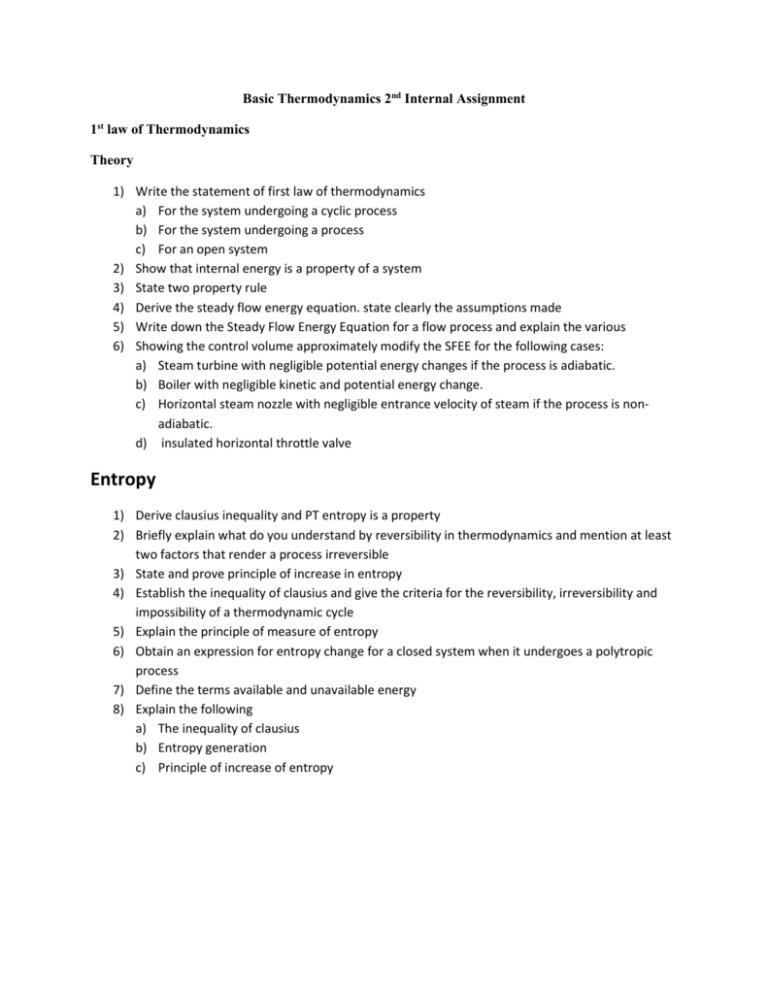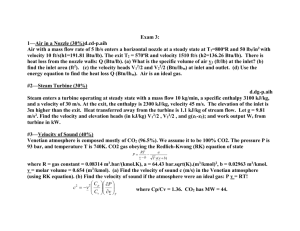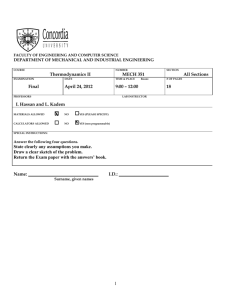BTD 2nd Internal
advertisement

Basic Thermodynamics 2nd Internal Assignment 1st law of Thermodynamics Theory 1) Write the statement of first law of thermodynamics a) For the system undergoing a cyclic process b) For the system undergoing a process c) For an open system 2) Show that internal energy is a property of a system 3) State two property rule 4) Derive the steady flow energy equation. state clearly the assumptions made 5) Write down the Steady Flow Energy Equation for a flow process and explain the various 6) Showing the control volume approximately modify the SFEE for the following cases: a) Steam turbine with negligible potential energy changes if the process is adiabatic. b) Boiler with negligible kinetic and potential energy change. c) Horizontal steam nozzle with negligible entrance velocity of steam if the process is nonadiabatic. d) insulated horizontal throttle valve Entropy 1) Derive clausius inequality and PT entropy is a property 2) Briefly explain what do you understand by reversibility in thermodynamics and mention at least two factors that render a process irreversible 3) State and prove principle of increase in entropy 4) Establish the inequality of clausius and give the criteria for the reversibility, irreversibility and impossibility of a thermodynamic cycle 5) Explain the principle of measure of entropy 6) Obtain an expression for entropy change for a closed system when it undergoes a polytropic process 7) Define the terms available and unavailable energy 8) Explain the following a) The inequality of clausius b) Entropy generation c) Principle of increase of entropy Numericals 1) A piston and cylinder machine contains fluid system, which passes through a complete cycle of four processes. during a cycle, the sum of all heat transfer is -170kj.the system completes 100 cycles per min. complete the following table showing the method for each item, compute the net rate of work output in KW Process Q(kj/min) W(kj/min) ΔE(kj/min) a-b 0 2170 b-c 21000 0 c-d -2100 -36600 d-a 2) A gas undergoes a thermodynamic cycle consisting of the following processes. i. Process 1-2:constant pressure ,P=1.4 bar,V1=0.028m3,1W2=10.5kj. ii. Process2-3:compression with PV=C,U3=U2 iii. Process 3-1:constant volume,(U1-U3)= -26.4kj There are no significant changes in KE and PE. I. II. III. IV. Sketch the cycle on a pP-V diagram Calculate the net work for the cyclein kj Calculate the heat transfer for process 1-2 ST ∑ 𝑄=∑ 𝑊 3) A gas of mass 1.5 kg undergoes a quasistatic expansion process following the relationship, p = a + bu, where ‘a’ and ‘b’ are constants. The initial and final pressures are 1000 kPa and 200 kPa respectively. The corresponding volumes are 0.2 m3 and 1.2 m3 respectively. The specific internal energy of the gas is given by the relation (1.5pv-85) kj/kg, where, p is in kPa and v is in m3/kg. Calculate the net heat transfer in its magnitude and direction. 4) A fluid is confined in a cylinder by spring a loaded Frictionless piston so that the pressure in the fluid is linear function of the volume (P= a + bV). The internal energy of the fluid is given by the following equation: U= 34+3.15PV where U is in kj, p in kPa and V in cubic metre. If the fluid changes from an initial state of 170 kPa, 0.03 m3 to a final state of 400 kPa. 0.06 m3. with no work other than that done on the piston and the direction and magnitude of the work and heat transfer. 5) A closed rigid vessel containing 10kg of oxygen at 290K is supplied with heat until its pressure becomes two fold that of initial value. Identify the process and calculate the final temperature, change in internal energy, and enthalpy and heat interaction across the system boundary. Take Cv= 0.65 kJ/Kg° K and R =259.8 J/kg K. 6) A cylinder contains 1 kg of a certain fluid at an initial pressure of 20 bar. the fluid is allowed to expand reversible behind a piston according to law pv2=C until the volume is doubled. The fluid is then cooled reversibly at constant pressure until the piston regains its original position. Heat is then supplied reversibly with the piston firmly locked in position until the pressure rises to the original value of 200 bar. Calculate the net work done by the fluid for an initial volume of 0.5m3. 7) A cylinder containing the air comprises the system. Cycle is completed as follows : (i) 82000 N-m of work is done by the piston on the air during compression stroke and 45 kJ of heat are rejected to the surroundings. (ii) During expansion stroke 100000 N-m of work is done by the air on the piston. Calculate the quantity of heat added to the system. 8) A fluid system undergoes a non-flow frictionless process following the pressure-volume relation as p =5/V + 1.5 where p is in bar and V is in m3. During the process the volume changes from 0.15 m3 to 0.05 m3 and the system rejects 45 kJ of heat. Determine : (i) Change in internal energy ;(ii) Change in enthalpy. 9) 90 kJ of heat are supplied to a system at a constant volume. The system rejects 95 kJ of heat at constant pressure and 18 kJ of work is done on it. The system is brought to original state by adiabatic process. Determine : (i) The adiabatic work ; (ii) The values of internal energy at all end states if initial value is 105 kJ. 10) 1 kg of ethane (perfect) gas is compressed from 1.1 bar, 27°C according to a law pV 1.3= constant, until the pressure is 6.6 bar. Calculate the heat flow to or from the cylinder walls. Given : Molecular weight of ethane = 30, cp = 1.75 kJ/kg K. 11) 0.15 m3 of an ideal gas at a pressure of 15 bar and 550 K is expanded isothermally to 4 times the initial volume. It is then cooled to 290 K at constant volume and then compressed back polytropically to its initial state. Calculate the net work done and heat transferred during the cycle. 12) A perfect gas undergoes a cycle comprises of 3 processes. it is first compressed isothermally from 1 bar and 270c to one-eighth of its initial volume. the energy is then added at constant pressure, increasing the temperature of gas and the cycle is completed by isentropic expansion to original conditions. Take cp=1.25kj/kg.K and R=0..5kj/kg.K. calculate the maximum cycle temperature and pressure. also find the work transfer per kg. 13) Process 1:air initially at 100kpa and 500c undergoes reversible adiabatic compression such that its volume is reduced to one-fifth of its initial volume. Process 2: 940kj/kg of heat is added to air to constant volume. Process 3: process 2 is followed by a reversible adiabatic expansion upto initial volume Process 4: finally,heat is rejected at constant volume soa s to reach the initial condition. Draw the 4 processes on a p-V diagram.determine the max temperature,net work done and hear rejected/kg of air assume adiabatic index of compression and expansion of 1.4 and constant volume cv=0.717 kj/kg.K Numerical on SFEE 14) A small turbine runs an aircraft refrigeration system. air enters the turbine at 4 bar and 400c with the velocity 40 m/s. at the exit the air is at 1 bar,2.50c and having a velocity of 200 m/s. if the work output of a turbine is 52 kj/kg of air, calculate the heat transferred per kg of air. 15) A fluid flows through a steady flow system at the rate of 3kg/s. The inlet and outlet conditions are p1=5 bar, V1 = 150 m/s, U1=2000kj/kg and p2=1.2 bar and V2=80 m/s and U2=1300 kj/kg. The changes in specific volume are from 0.4 m3/kg to 1.1 m3/kg. The fluid loses 25 kj/kg heat during the process. Neglecting PE Determine Power o/p of the system. 16) During a steady flow process 1.2kg/s of fluid passes through a system in which the exit pipe is 3 m below the level of the connection. find the power developed by the system if the pressure decreases from 7 to 1.2 bar, velocity increases from 60 to 400 m/s, internal energy decreases by 50 kj/kg, sp vol increases from 0.03 to 0.2 m3/kg and heat lost by the system is 10,500 kj/hr. 17) A turbine operating under steady flow conditions receives system at the following state: Pressure = 13.8 bar, sp vol =0.143 m3/kg, specific internal energy = 2590 kj/kg, Velocity =30 m/s. the state of the steam leaving the turbine is as follows: Pressure=0.35 bar, sp volume = 4.37 m3/kg, specific internal energy = 2360 kj/kg, velocity = 90 m/s. heat is rejected to the surrounding at the rate of 0.25 kw and the rate of steam flow through the turbine is 0.38 kg/s. calculate the power developed by the turbine 18) 12 kg of air per mm is delivered by a centrifugal compressor. Pressure sp. Vol and velocity of air at the inlet are: 1 bar, 0.5 m3/kg and 10 m/s respectively and the corresponding values at the outlet are : 9 bar, 0.14 m3 /kg and 90 m/s. While passing through the compressor. Enthalpy of air increases by 150 kJ/kg and heat loss to the surroundings is 12 kW. Find i) Motor power required to drive the compressor ii) Ratio of inlet to outlet pipe diameters. 19) The working fluid, in a steady flow process flows at a rate of 220 kg/mm. The fluid rejects 100 kj/s of heat passing through the system. The conditions of the fluid at inlet and outlet are given as velocity = 220 m/s. P1= 6.0 bar, u1 = 2000 KJ/kg. v1 = 0.36 m3/kg and velocity= 140 m/s, P2 = 1.2 bar, U2= 1400 KJ/kg, v2 1.3 m3/kg. The suffix ‘1’ indicates condition at inlet and 2 at outlet. Determine the power capacity of the system in MW. 20) A fluid flows through a steam turbine at a steady rate of 5000 kg/hr, while energy is transferred as heat at the rate of 6279 kj/hr from the turbine. The condition of the fluid at the turbine inlet and exit are as follows: Enthalpy: h1=3153 kJ/kg h2 = 2713kJ/kg Velocity : C1 =6O m/s C2= 185 m/s elevation Z1=6 m Z2= 4 m Find the power output from the turbine. Comment on Kinetic energy & potential energy changes. 21) Air flows steadily at the rate of 0.5 kg/s through an air compressor, entering at 7 m/s velocity, 100 kPa pressure, 0.95m3/kg volume and leaves at 5 m/s velocity, 700 kPa pressure and 0.19 m3/kg volume. The internal energy of air leaving is 93 kJ/kg greater than that of the air entering. Cooling water in the compressor jackets absorbs heat from the air at the rate of 58 kW. i) Compute the rate of shaft work in kW. ii) Find the ratio of the inlet pipe diameter to outlet pipe diameter 22) The inlet to a certain nozzle, the enthalpy of the fluid passing is 3000 kJ/kg and the velocity is 60 m/s. At the discharge end, the enthalpy is 2762 kj/kg. The nozzle is horizontal and there is negligible heat loss from it. Find i) the velocity at the exit from the nozzle. ii) If the inlet area is 0.1 m2 and specific volume at inlet is 0.187 m3/kg, find the mass flow rate. iii) If the specific volume at the nozzle exit is 0.498 m3/kg, find the exit area of the nozzle. 23) Steam at the rate of 0.42 kg/s and enthalpy of 2785 kJ/kg and a velocity of 33.3 m/s is supplied to a steadily operating turbine. The steam leaves the turbine at 100 m/s and an enthalpy of 2512 kj/kg. the inlet pipe is 3 m above the exit pipe. Rate of heat loss from the turbine casing is 0.29 kJ/s. What is the power output of the turbine? 24) A steam turbine operating under steady flow conditions receives 4500kg of steam per hour. the steam enters the turbine at a velocity of 42 m/s at the elevation of 4 m and a sp enthalpy of 2800 kj/kg. it leaves the turbine at a velocity of 9.4 m/s at an elevation of 1 m and sp enthalpy of 2262 kj/kg. the heat losses from the turbine to the surrounding amounts to 16780kj/hr. determine the power o/p of the machine 25) Air flows steadly through a rotary compressor. At entry the air is 200c and 101 kpa.at exit the same air is at 2000c and 600 kpa.assuming the flow to be adiabatic. i)Evaluate the WD/mass of air if the velocities at inlet and exit are negligible. ii)What should be the increase in work increase in work input if the velocities at inlet and outlet are 50 m/s and 110 m/s 26) The power developed by a turbine in a certain steam plant is 1200 kW. The heat supplied to the steam in the boiler is 3360 kJ/kg, the heat rejected by the system to cooling water in the condenser is 2520 kJ/kg and the feed pump work required to pump the condensate back into the boiler is 6 kW. Calculate the steam flow round the cycle in kg/s. 27) The working fluid, in a steady flow process flows at a rate of 220 kg/min. The fluid rejects 100 kJ/s passing through the system. The conditions of the fluid at inlet and outlet are given as : C1 = 320 m/s, p1 = 6.0 bar, u1 = 2000 kJ/kg, v1 = 0.36 m3/kg and C2 = 140 m/s, p2 = 1.2 bar, u2 = 1400 kJ/kg, v2 = 1.3 m3/kg. The suffix 1 indicates the condition at inlet and 2 indicates at outlet of the system. Determine the power capacity of the system in MW. The change in potential energy may be neglected. 28) In a test of water cooled air compressor, it is found that the shaft work required to drive the compressor is 175 kJ/kg of air delivered and the enthalpy of air leaving is 70 kJ/kg greater than that entering and that the increase in enthalpy of circulating water is 92 kJ/kg. Compute the amount of heat transfer to the atmosphere from the compressor per kg of air. 29) A centrifugal pump delivers 50 kg of water per second. The inlet and outlet pressures are 1 bar and 4.2 bar respectively. The suction is 2.2 m below the centre of the pump and delivery is 8.5 m above the centre of the pump. The suction and delivery pipe diameters are 20 cm and 10 cm respectively. Determine the capacity of the electric motor to run the pump.








